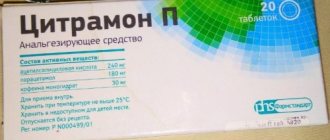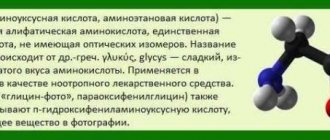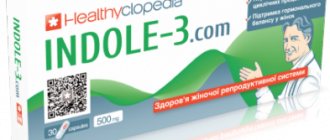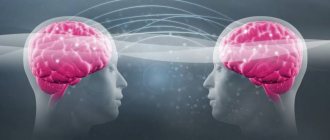Write a review
Reviews: 0
Manufacturers: UPSA Laboratoires
Active ingredients
- Acetylsalicylic acid
- Caffeine
- Paracetamol
Disease class
- Other and unspecified lesions of the oral mucosa
- Joint pain
- Myalgia
- Headache
- Other constant pain
- Dysmenorrhea, unspecified
Clinical and pharmacological group
- Not indicated. See instructions
Pharmacological action
- Not indicated. See instructions
Pharmacological group
- NSAIDs - Salicylic acid derivatives in combinations
Exedrin oral tablets
Instructions for medical use of the drug
Description of pharmacological action
Excedrin® is a combination drug containing paracetamol, acetylsalicylic acid and caffeine. Paracetamol has an analgesic, antipyretic and extremely weak anti-inflammatory effect, which is associated with its effect on the thermoregulation center in the hypothalamus and a weak ability to inhibit the synthesis of prostaglandins in peripheral tissues. Acetylsalicylic acid has analgesic, antipyretic and anti-inflammatory effects. Quickly relieves pain, especially caused by the inflammatory process, and also moderately inhibits platelet aggregation and slows down the process of thrombus formation, improving microcirculation at the site of inflammation. Caffeine increases the reflex excitability of the spinal cord, stimulates the respiratory and vasomotor centers, dilates the blood vessels of skeletal muscles, brain, heart, kidneys, and reduces platelet aggregation. Reduces drowsiness, fatigue, increases mental and physical performance. In this combination, caffeine in a small dose has virtually no stimulating effect on the central nervous system, but helps to normalize cerebral vascular tone and accelerate blood flow in it.
Indications for use
Pain syndrome of moderate and mild intensity of various origins: headache, migraine, toothache, neuralgia, arthralgia and myalgia (pain in muscles and joints), algodismenorrhea (pain during menstruation).
Release form
pills; package 16; film-coated tablets; laminated aluminum foil bag 2, cardboard pack 1; film-coated tablets; blister 10, cardboard pack 1; film-coated tablets; blister 10, cardboard pack 2; film-coated tablets; blister 10, cardboard pack 3; film-coated tablets; polypropylene bottle (bottle) 50, cardboard pack 1; film-coated tablets; polypropylene bottle (bottle) 24, cardboard pack 1; Composition 1 tablet (caplet) contains paracetamol 250 mg, aspirin 250 mg and caffeine 65 mg; per pack 16 pcs.
Pharmacodynamics
Excedrin is a combination drug containing paracetamol, acetylsalicylic acid and caffeine. Paracetamol has an analgesic, antipyretic and extremely weak anti-inflammatory effect, which is associated with its effect on the thermoregulation center in the hypothalamus and a weak ability to inhibit the synthesis of prostaglandins in peripheral tissues. Acetylsalicylic acid has analgesic, antipyretic and anti-inflammatory effects. Quickly relieves pain, especially caused by the inflammatory process, and also moderately inhibits platelet aggregation and slows down the process of thrombus formation, improving microcirculation at the site of inflammation. Caffeine increases the reflex excitability of the spinal cord, stimulates the respiratory and vasomotor centers, dilates the blood vessels of skeletal muscles, brain, heart, kidneys, and reduces platelet aggregation. Reduces drowsiness, fatigue, increases mental and physical performance. In this combination, caffeine in a small dose has virtually no stimulating effect on the central nervous system, but helps to normalize cerebral vascular tone and accelerate blood flow in it.
Pharmacokinetics
Paracetamol is easily absorbed from the gastrointestinal tract, Cmax in blood plasma is detected from 30 minutes to 2 hours after administration. Paracetamol is metabolized in the liver and excreted by the kidneys, mainly in the form of glucuronides and sulfate conjugates. Less than 5% of paracetamol is excreted unchanged. The duration of T1/2 varies from 1 to 4 hours. Communication with plasma proteins is negligible at usual therapeutic doses, however, it increases as the dose increases. The hydroxylated metabolite, formed in small quantities in the liver under the influence of mixed oxidases and usually neutralized by binding to glutathione, can accumulate during an overdose of paracetamol and cause liver damage. Acetylsalicylic acid is quickly and completely absorbed, undergoes rapid hydrolysis in the gastrointestinal tract, liver and blood to the formation of salicylates, which undergo further metabolism, mainly in the liver. Caffeine is completely and quickly absorbed. Maximum concentrations are observed between 5 and 90 minutes after administration on an empty stomach. In adults, elimination occurs almost entirely through hepatic metabolism. There is marked variability in individual elimination values in adults. The average T1/2 from blood plasma is 4.9 hours in the range of 1.9-12.2 hours. Caffeine is distributed in all body fluids. The binding of caffeine to plasma proteins is 35%. Caffeine is almost completely metabolized by oxidation, demethylation and acetylation and is excreted by the kidneys. Main metabolites: 1-methylxanthine, 7-methylxanthine, 1.7-dimethylxanthine.
Use during pregnancy
Despite the fact that acetylsalicylic acid can be used in the second trimester of pregnancy, the safety of this combination in pregnant and breastfeeding women has not been studied, therefore the drug is contraindicated in pregnant women (in all trimesters) and breastfeeding women.
Use for renal impairment
Contraindicated: renal failure.
Contraindications for use
Hypersensitivity to any of the components in the drug, erosive and ulcerative lesions of the gastrointestinal tract in the acute phase, gastrointestinal bleeding, complete or incomplete combination of bronchial asthma, recurrent polypnosis of the nose and paranasal sinuses and intolerance to acetylsalicylic acid or other non-steroidal anti-inflammatory drugs (including including a history), surgical interventions accompanied by bleeding, hemophilia, hemorrhagic diathesis, hypoprothrombinemia, severe arterial hypertension, portal hypertension, severe ischemic heart disease, glaucoma, vitamin K deficiency, renal failure, simultaneous use of other drugs containing paracetamol, acetylsalicylic acid or other non-steroidal anti-inflammatory drug, glucose-6-phosphate dehydrogenase deficiency, pregnancy, lactation, increased excitability, sleep disorders, children under 15 years of age (risk of developing Reye's syndrome in children with hyperthermia due to viral diseases). Carefully. Gout, liver disease, headaches associated with head trauma, taking anticoagulants, hypoglycemic agents, gout or arthritis, as well as concomitant use of drugs containing acetylsalicylic acid or other analgesic and antipyretic components.
Side effects
Gastralgia, nausea, vomiting, hepatotoxicity, nephrotoxicity, erosive and ulcerative lesions of the gastrointestinal tract, allergic reactions, tachycardia, increased blood pressure, bronchospasm. With long-term use - dizziness, headache, visual impairment, tinnitus, decreased platelet aggregation, hypocoagulation, hemorrhagic syndrome (epistaxis, bleeding gums, purpura, etc.), kidney damage with papillary necrosis, deafness, malignant exudative erythema (syndrome) Stevens-Johnson), toxic epidermal necrolysis (Lyell's syndrome), Reye's syndrome in children (hyperpyrexia, metabolic acidosis, nervous system and mental disorders, vomiting, liver dysfunction).
Directions for use and doses
The drug is taken orally during or after meals. Adults and adolescents over 15 years of age: 1 tablet every 4-6 hours. At the first sign of migraine, take 2 tablets. The average daily dose is 3-4 tablets per day, the maximum daily dose is 6 tablets per day. After taking 2 tablets, relief from headaches and other types of pain usually occurs quickly - within 15 minutes; for migraines, relief usually occurs within 30 minutes. In case of pain, the drug should not be taken for more than 5 days without consulting a doctor. For migraines, the drug should not be taken for more than 3 days without consulting a doctor.
Overdose
Symptoms caused by the presence of paracetamol (when taken in doses of more than 10-15 g/day): during the first 24 hours, pallor of the skin, nausea, vomiting, anorexia, abdominal pain, impaired glucose metabolism, metabolic acidosis. Symptoms of liver dysfunction may appear 12-48 hours after an overdose. In case of severe overdose - liver failure with progressive encephalopathy, coma, death; acute renal failure with tubular necrosis (including in the absence of severe liver damage); arrhythmia, pancreatitis. The hepatotoxic effect in adults occurs when taking 10 g or more. Symptoms caused by the presence of acetylsalicylic acid (when taken in doses of more than 150 mg/kg): for mild intoxication - nausea, vomiting, tinnitus, blurred vision, dizziness, severe headache. In severe poisoning - hyperventilation of the lungs of central origin (shortness of breath, suffocation, cyanosis, cold sticky sweat, respiratory paralysis), respiratory acidosis. The greatest risk of developing chronic intoxication is observed in children and the elderly when taking more than 100 mg/kg/day for several days. For moderate to severe poisoning, hospitalization is required. Symptoms caused by the presence of caffeine (when taken in doses of more than 300 mg / day): gastralgia, agitation, anxiety, agitation, restlessness, confusion, delirium, dehydration, tachycardia, arrhythmia, hyperthermia, frequent urination, headache, increased tactile or pain sensitivity, tremors or muscle twitching; nausea and vomiting, sometimes with blood; ringing in the ears, epileptic seizures (in case of acute overdose - tonic-clonic). Treatment: monitoring the acid-base status and electrolyte balance. Depending on the metabolic state, administration of sodium bicarbonate, sodium citrate or sodium lactate. Increasing alkalinity enhances the excretion of acetylsalicylic acid due to alkalinization of urine. Gastric lavage in the first 4 hours, provocation of vomiting, taking activated charcoal, laxatives, administration of SH-group donors and precursors for the synthesis of glutathione methionine within 8-9 hours after an overdose and acetylcysteine - within 8 hours.
Interactions with other drugs
The drug may enhance the effect of heparin, indirect coagulants, reserpine, steroid hormones and hypoglycemic drugs. Concomitant use with other non-steroidal anti-inflammatory drugs and methotrexate increases the risk of side effects. Reduces the effectiveness of spironolactone, furosemide, antihypertensive drugs, as well as anti-gout drugs that promote the excretion of uric acid. Barbiturates, rifampicin, salicylamide, antiepileptic drugs and other inducers of microsomal liver enzymes contribute to the formation of toxic paracetamol metabolites that affect liver function. Metoclopramide accelerates the absorption of paracetamol. Under the influence of paracetamol, the half-life of chloramphenicol increases 5 times. When taken repeatedly, paracetamol may enhance the effect of anticoagulants (coumarin derivatives). Simultaneous use of paracetamol, acetylsalicylic acid and alcoholic beverages increases the risk of developing hepatotoxic effects. Caffeine accelerates the absorption of ergotamine.
Special instructions for use
If symptoms persist, worsen, or new symptoms occur after taking the drug, you should immediately consult a doctor. When taking the drug at the recommended dose, the body receives the same amount of caffeine as is contained in one cup of coffee, so you should reduce the consumption of caffeine-containing products when treating with this drug in order to avoid the development of nervous agitation, irritability, insomnia and rapid heartbeat due to caffeine overdose. If you suspect an overdose, seek immediate medical attention, even if you have no symptoms. You should avoid drinking alcohol while taking the drug due to an increased risk of liver damage and gastrointestinal bleeding. Since acetylsalicylic acid slows down blood clotting, a patient undergoing surgery should notify the doctor in advance about taking the drug. Acetylsalicylic acid in low doses reduces the excretion of uric acid, and therefore in patients with a predisposition, the drug can provoke an attack of gout. With prolonged use of the drug, monitoring of peripheral blood and the functional state of the liver is necessary. Impact on the ability to drive vehicles and operate machinery. The effect of the drug on the ability to drive a car and operate machinery has not been reported.
Storage conditions
In a dry place, at a temperature not exceeding 25 °C.
Best before date
60 months
ATX classification:
N Nervous system
N02 Analgesics
N02B Analgesics and antipyretics
N02BA Salicylic acid and its derivatives
N02BA71 Acetylsalicylic acid in combination with psychotropic drugs
Exedrin
Acetylsalicylic acid
quickly and completely absorbed from the gastrointestinal tract, 70% reaches the bloodstream unchanged, 30% undergoes hydrolysis in the gastrointestinal tract to form salicylic acid. The maximum concentration in blood plasma is achieved 1-2 hours after a single dose. Eating slows down absorption, but does not affect its completeness.
Salicylic acid
spreads to all tissues and fluids of the body, including the central nervous system (CNS). Acetylsalicylic and salicylic acids are partially bound to plasma proteins, mainly albumin.
Salicylic acid passes through the placenta and is excreted in breast milk.
Acetylsalicylic acid in the blood plasma undergoes hydrolysis to salicylic acid (with a half-life of 15-20 minutes), so that acetylsalicylic acid is practically undetectable in the blood plasma 1-2 hours after administration. Salicylic acid is metabolized in the liver. After a single dose of 1 g of acetylsalicylic acid, the average half-life of salicylic acid is about 6 hours.
Salicylic acid and its metabolite are excreted by the kidneys through glomerular filtration and tubular secretion. Excretion of unchanged drug through the kidneys depends on the pH of the urine.
Caffeine
completely and quickly absorbed from the gastrointestinal tract. Maximum concentrations are observed between 5 and 120 minutes after administration on an empty stomach, depending on the dose, the patient's health status and concomitant medications. In adults, elimination occurs almost entirely through hepatic metabolism. There is marked variability in individual elimination values in adults. The average half-life from blood plasma is 4.9 hours, range 1.9 hours - 12.2 hours. Caffeine is distributed in all body fluids. The binding of caffeine to plasma proteins is 35%. Caffeine is almost completely metabolized by oxidation, demethylation and acetylation and is excreted by the kidneys. Main metabolites: 1-methylxanthine, 7-methylxanthine, 1,7-dimethylxanthine.
Paracetamol
easily absorbed from the gastrointestinal tract, maximum plasma concentrations are detected between 30 minutes and 2 hours after administration. Paracetamol is metabolized in the liver and excreted by the kidneys, mainly in the form of glucuronides and sulfate conjugates. Less than 5% of paracetamol is excreted unchanged.
The half-life varies from 1 to 4 hours. Plasma protein binding is negligible at normal therapeutic doses, however, it increases as the dose increases. The hydroxylated metabolite, formed in small quantities in the liver under the influence of mixed oxidases and usually neutralized by binding to glutathione, can accumulate during an overdose of paracetamol and cause liver damage.
Similar drugs:
- Carsil Dragee
- Ascorutin Oral tablets
- Yogurt Capsule
- Ergoferon () Lozenges
- Magne B6 Oral tablets
- Omez Capsule
- Papaverine Oral tablets
** The Drug Directory is intended for informational purposes only. For more complete information, please refer to the manufacturer's instructions. Do not self-medicate; Before you start using Excedrin, you should consult your doctor. EUROLAB is not responsible for the consequences caused by the use of information posted on the portal. Any information on the site does not replace medical advice and cannot serve as a guarantee of the positive effect of the drug.
Are you interested in Excedrin? Do you want to know more detailed information or do you need a doctor's examination? Or do you need an inspection? You can make an appointment with a doctor - the Euro lab is always at your service! The best doctors will examine you, advise you, provide the necessary assistance and make a diagnosis. You can also call a doctor at home . Euro lab clinic is open for you around the clock.
** Attention! The information presented in this medication guide is intended for medical professionals and should not be used as a basis for self-medication. The description of the drug Excedrin is provided for informational purposes only and is not intended for prescribing treatment without the participation of a doctor. Patients need to consult a specialist!
If you are interested in any other drugs and medications, their descriptions and instructions for use, information about the composition and form of release, indications for use and side effects, methods of use, prices and reviews of drugs, or you have any other questions and suggestions - write to us, we will definitely try to help you.








